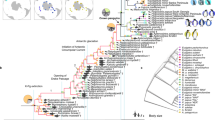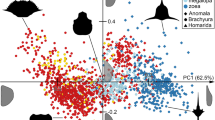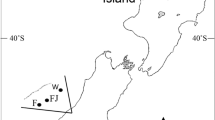Abstract
Crabs of the family Grapsidae are abundant organisms in most intertidal communities. However, relatively few species live in complete independence of the sea1. Of those species that do, Jamaica's nine endemic species of land crabs are unique in their exceptional adaptations to terrestrial life, which include the only active brood-care for larvae and juveniles known in crabs2,3,4,5,6. These adaptations, and the morphological similarity to a group of southeast Asian land-dwelling crabs, have raised the question of the number and age of land invasions of the Jamaican species. Here we present molecular evidence that Jamaican land crabs represent a single adaptive radiation from a marine ancestor that invaded terrestrial habitats only 4 million years (Myr) ago. A Late-Tertiary origin has also been found for lizards and frogs of Jamaica7,8,9 and probably reflects the Mid-Tertiary inundation of that island10.
This is a preview of subscription content, access via your institution
Access options
Subscribe to this journal
Receive 51 print issues and online access
$199.00 per year
only $3.90 per issue
Buy this article
- Purchase on Springer Link
- Instant access to full article PDF
Prices may be subject to local taxes which are calculated during checkout


Similar content being viewed by others
References
Hartnoll, R. G. in Biology of the Land Crabs (eds Burggren, W. W. & McMahon, B. R.) 6–54 (Cambridge Univ. Press, Cambridge, (1988)).
Diesel, R. Parental care in an unusual environment: Metopaulias depressus (Decapoda: Grapsidae), a crab that lives in epiphytic bromeliads. Anim. Behav. 38, 561–575 (1989).
Diesel, R. Maternal control of calcium concentration in the larval nursery of the bromeliad crab, Metopaulias depressus (Grapsidae). Proc. R. Soc. Lond. B 264, 1403–1406 (1997).
Diesel, R. & Schuh, M. Maternal care in the bromeliad crab, Metopaulias depressus (Decapoda): maintaining oxygen, pH and calcium levels optimal for the larvae. Behav. Ecol. Sociobiol. 32, 11–15 (1993).
Diesel, R. Maternal care in the bromeliad crab, Metopaulias depressus : protection of larvae from predation by damselfly nymphs. Anim. Behav. 43, 803–812 (1992).
Diesel, R. & Horst, D. Breeding in a snail shell: ecology and biology of the Jamaican montane crab Sesarma jarvisi (Decapoda: Grapsidae). J. Crust. Biol. 15, 179–195 (1995).
Hedges, S. B. & Burnell, K. L. The Jamaican radiation of Anolis (Sauria: Iguanidae): an analysis of relationships and biogeography using sequential electrophoresis. Carib. J. Sci. 26, 31–44 (1990).
Hedges, S. B. An island radiation: allozyme evolution in Jamaican frogs of the genus Eleutherodactylus (Leptodactylidae). Carib. J. Sci. 25, 123–147 (1989).
Hass, C. A. & Hedges, S. B. Albumin evolution in West Indian frogs of the genus Eleutherodactylus (Leptodactylidae): Caribbean biogeography and a calibration of the albumin immunological clock. J. Zool. 225, 413–426 (1991).
Hedges, S. B. Historical biogeography of West Indian vertebrates. Annu. Rev. Ecol. Syst. 27, 163–196 (1996).
Hartnoll, R. G. The freshwater grapsid crabs of Jamaica. Proc. Linn. Soc. Lond. 175, 145–169 (1964).
Schubart, C. D., Reimer, J., Diesel, R. & Türkay, M. Taxonomy and ecology of two endemic freshwater crabs from western Jamaica with the description of a new Sesarma species (Brachyura: Grapsidae: Sesarminae). J. Nat. Hist. 31, 403–419 (1997).
Hartnoll, R. G. Sesarma cookei n. sp., a grapsid crab from Jamaica (Decapoda, Brachyura). Crustaceana 20, 257–262 (1971).
Serène, R. & Soh, C. L. New Indo-Pacific genera allied to Sesarma Say 1817 (Brachyura, Decapoda, Crustacea). Treubia 27, 387–416 (1970).
Holthuis, L. B. in Stygofauna Mundi (ed. Botosaneanu, L.) 589–615 (Leiden, (1986)).
Guinot, D. in Encyclopedia Biospeologica (eds Jubertine, C. & Decou, V.) 165–179 (Société de Biospéologie, Moulis et Bucarest, (1994)).
Swofford, D. L. Phylogenetic Analysis using Parsimony (PAUP) (Univ. Illinois, Champaign, (1993)).
Kumar, S., Tamura, K. & Nei, M. MEGA: Molecular Evolutionary Genetics Analysis (Pennsylvania State Univ., University Park, (1993)).
Keigwin, L. Isotopic paleoceanography of the Caribbean and East Pacific: role of Panama uplift in late neogene time. Science 217, 350–353 (1982).
Coates, A. G. et al. Closure of the Isthmus of Panama: the near-shore marine record of Costa Rica and western Panama. Geol. Soc. Am. Bull. 104, 814–828 (1992).
1. Cunningham, C. W., Blackstone, N. W. & Buss, L. W. Evolution of king crabs form hermit crabs ancestors. Nature 355, 539–542 (1992).
Knowlton, N., Weight, L. A., Solórzano, L. A., Mills, D. K. & Bermingham, E. Divergence in proteins, mitochondrial DNA, and reproductive compatibility across the Isthmus of Panama. Science 260, 1629–1632 (1993).
Carroll, R. L. Revealing the patterns of macroevolution. Nature 381, 19–20 (1996).
Brusca, R. C. & Brusca, G. J. Invertebrates (Sinauer, Sunderland, MA, (1990)).
Abele, L. G. Areview of the grapsid crab genus Sesarma (Crustacea: Decapoda: Grapsidae) in America, with the description of a new genus. Smithson. Contrib. Zool. 527, 1–60 (1992).
Haq, B. U., Hardenbol, J. & Vail, P. R. Chronology of fluctuating sea levels since the Triassic. Science 235, 1156–1167 (1987).
Williamson, M. Island Populations (Oxford Univ. Press, Oxford, (1981)).
Palumbi, S. R. et al. The Simple Fool's Guide to PCR. A Collection of PCR Protocols (University of Hawaii, Honolulu, (1991)).
Cabot, E. L. & Beckenbach, A. T. Simultaneous editing of multiple nucleic acid and protein sequences with ESEE. Comp. Appl. Biosci. 5, 233–234 (1989).
Takezaki, N., Rzhetsky, A. & Nei, M. Phylogenetic test of the molecular clock and linearized trees. Mol. Biol. Evol. 12, 823–833 (1995).
Acknowledgements
We thank P. K. L. Ng, L. G. Abele and D. L. Felder for specimens; M. Schuh, G.Bäurle, D. Horst, J. A. Cuesta, J. Christy, DBML, STRI and IN.RE.NA.RE for support during collections; M. Frye, S. Kumar, and I. Ruvinsky for methodological advice; S. Kumar for the program PHYLTEST; E. Geißler and A. Beausang for help with figures; and C. A. Hass, S. Kumar, J. Reimer, and Cl.Schubart for comments on the manuscript. This project was funded by the DFG (C.D.S. and R.D.) and NSF (S.B.H.).
Author information
Authors and Affiliations
Corresponding author
Rights and permissions
About this article
Cite this article
Schubart, C., Diesel, R. & Hedges, S. Rapid evolution to terrestrial life in Jamaican crabs. Nature 393, 363–365 (1998). https://doi.org/10.1038/30724
Received:
Accepted:
Issue Date:
DOI: https://doi.org/10.1038/30724
This article is cited by
-
Molecular phylogeny and historical biogeography of marine palaemonid shrimps (Palaemonidae: Palaemonella–Cuapetes group)
Scientific Reports (2022)
-
Diversification and distribution of gall crabs (Brachyura: Cryptochiridae: Opecarcinus) associated with Agariciidae corals
Coral Reefs (2022)
-
The biogeographic history of the relictual Gondwanan lineage of Australian burrowing crayfish
Hydrobiologia (2021)
-
New insights into the genetic diversity of the stone crayfish: taxonomic and conservation implications
BMC Evolutionary Biology (2020)
-
Geographical and temporal origins of Neocaridina species (Decapoda: Caridea: Atyidae) in Taiwan
BMC Genetics (2019)
Comments
By submitting a comment you agree to abide by our Terms and Community Guidelines. If you find something abusive or that does not comply with our terms or guidelines please flag it as inappropriate.



